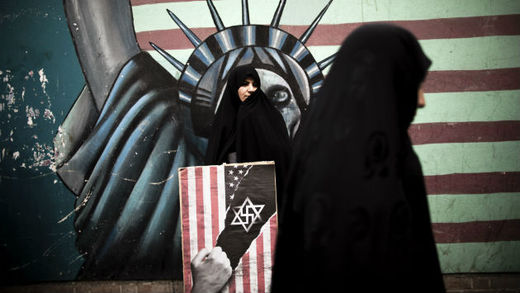
© BEHROUZ MEHRI/AFP/Getty ImagesAnti-US sentiment alive and strong in Iran
Despite recent signs of a thaw in relations between Washington and Tehran, Iran is going ahead with a 34-year-old November ritual: anti-U.S. demonstrations to commemorate the takeover of the U.S. Embassy in Tehran.
With each passing year, the impact of the annual protests has diminished. But the anniversary still symbolizes tensions and mistrust at the center of the U.S.-Iran relationship, and hard-line conservatives are calling for "death to America" chants to be a key part of Monday's event.
Now under the control of the hard-line Student Basij Organization, the old embassy grounds remain known here as the "Den of Espionage,'' and anti-American propaganda fills the walls inside and outside the compound.
The property - bordered by an imposing brick wall that hundreds of students scaled on Nov. 4, 1979, seizing the embassy and its occupants - is a vast piece of prime real estate in what was then the city's commercial center.
Only rarely is the compound open to the public, but its doors were flung wide in the week leading up to this year's anniversary, and foreign visitors - including a few Americans - went on a tour.
"Why not?'' guide Mohammad Reza Shoghi said when the Americans asked whether they could see a bit more of the grounds. "It belongs to you.''
Given the recent warmer words between the U.S. and Iranian presidents, artifacts in the compound seem to be relics from another era: an American flag painted on the driveway, cracked down the middle; a replica of the Statue of Liberty whose midsection is made up of prison bars trapping a pair of doves; the Great Seal of the United States, mangled by a chisel but still recognizable; and countless posters recounting alleged U.S. atrocities around the world.
In the shah's time, the street alongside the embassy was named Roosevelt. Now it is called Mofatteh, after a revolutionary cleric and university professor.
The lone building open to visitors was once the consular section, the top floor of which, its current occupiers say, housed a secret CIA unit dedicated to spying on Iranians. Past a series of doors and corridors are rooms filled with communications equipment - high-tech at that time - along with documents, many of them pieced together from shreds. Revolutionary loyalists have long contended that the building's contents provide ample evidence of U.S. spying activities in the 1970s.
Shoghi, the guide, works for the organization that oversees the property, and he is adept in spelling out Iran's official version of events. He explained that the 52 American hostages were treated well during their 444 days of captivity, even though, he said, all had been working as spies.
One former hostage, John Limbert, served briefly under President Obama as deputy assistant secretary of state for Iranian affairs. He has called for more-open communication between Washington and Tehran as a step toward renewing ties. But he also says that what he and the other hostages endured cannot be justified.
Limbert, a professor at the U.S. Naval Academy, said in an e-mail exchange that the hostage-takers are guilty of "violating a trust and ignoring responsibility for safety of guests in their midst" and that "no amount of rationalization can change that reality."
A number of former hostage-takers were contacted for this report, but none agreed to answer questions related to those events. In the past, they have said that their actions were necessary under the circumstances.
Masoumeh Ebtekar, the fluent-English-speaking spokeswoman for the hostage-takers, said in a panel discussion this year that she and others who took over the embassy "never regretted what we did, and our action must be assessed based on the situation of that period."
"I think the decision was the best thing we could do to protect the revolution,'' Ebtekar said at the event, organized to promote discussion of "Argo," the Academy Award-winning film that told the story of a CIA mission to smuggle several U.S. Foreign Service workers, hidden by Canadian diplomats, out of Tehran.
Ebtekar, who was a teenager at the time, went on to become the first female vice president since the Islamic revolution, and she wrote a book in English on the hostage crisis called "
Takeover in Tehran."
Her attitude about the events, according to another chronicler, is shared by many of her cohorts.
"While some certainly regretted the reverberations their action set off, they dismissed the judgment of international law in favor of demanding justice in their immediate situation," said David Harris, whose 2004 book "
The Crisis: The President, the Prophet and the Shah" is based on interviews with most of the principals on both sides of the ordeal.
Chance for rapprochementThis year's run-up to the Nov. 4 demonstrations has included some public debate in Iran about whether it is time to put an end to the "death to America'' chants. But hard-liners who are uncomfortable with the recent warming of relations have called for the slogan to receive special emphasis.
Limbert and other former hostages say such rhetoric cannot be permitted to stand in the way of rapprochement.
"For those of us on the political side, we were originally in Tehran because we believed then, in 1979, that the U.S. and the new revolutionary Iran needed to talk," Limbert said in the e-mail exchange.
In a recent article for the Middle East Institute, Limbert predicted that "once Iranian and American representatives begin talking . . . they will soon ask themselves: 'What was all the fuss about, and why did we waste 34 years quarreling?' "
Reader Comments
to our Newsletter